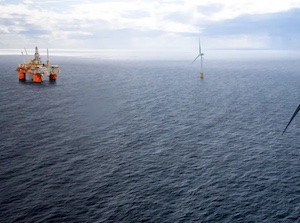Hywind Tampen: the world’s first renewable power for offshore oil and gas
Options
Hywind Tampen: the world’s first renewable power for offshore oil and gas

With a system capacity of 88 MW it will also be the world’s largest floating offshore wind farm and an essential step in industrialising solutions and reducing costs for future offshore wind power projects.
When Hywind Tampen is operational, Equinor will operate nearly half (47 percent) of the world’s floating wind capacity.
Hywind Tampen will be a test bed for further development of floating wind, exploring the use of new and larger turbines, installations methods, simplified moorings, concrete substructures and integration between gas and wind power generation systems.
The floating wind farm will consist of 11 wind turbines upgraded from 8 to 8.6 MW. The capacity in the export system and on the platforms has not been upgraded accordingly, however the increased capacity could contribute to increased yearly total production due to increased uptime. Operational experience with the completed facilities can also contribute to improve the production capacity through increased utilisation rate.
The wind farm is estimated to meet about 35% of the annual electricity power demand of the five Snorre A and B, and Gullfaks A, B and C platforms. In periods of higher wind speed this percentage will be significantly higher.
The wind power solution will help reduce the use of gas turbine power for the Snorre and Gullfaks offshore fields, while also offsetting 200,000 tonnes of CO2 emissions and 1,000 tonnes of NOx emissions per year.
The project will contribute to further developing floating offshore wind technology and reducing the costs of future floating offshore wind farms, offering new industrial opportunities for Norway, the licences and Norwegian supplier industry in a growing global offshore wind market.

- The partners: Equinor, Petoro, OMV, Vår Energi, Wintershall Dea and INPEX Idemitsu Norge AS.
- Total system capacity of 88 MW.
- About 140 km off the Norwegian coast.
- Water depth between 260 and 300 metres.
- Installed on floating concrete structures with a shared anchoring system.
- The wind turbines will be connected in a 2.5 km-long inter-array network with a capacity of 66 kV.
- Scheduled to start producing power in the third quarter of 2022.